Weathering With You: Spoiler-free (if not none) impressions
The highly anticipated “Weathering With You” has been released across Japan on 18-July.
Shinkai Makoto’s previous “Your Name” deserved the artistical acclaim and the massive commercial success, but this another masterpiece does live up to and even exceed the elevated expectations. This post is by no means meant to spoil the joy of apprecieating latest Shinkai’s artwork, but to raise the expectations further by providing spoiler-free impressions (though any advance information could become a noisy preconception).
Overall impressions:
- Life-affirming theme eminates across the movie and we (audience) could easily feel (if not “measure”) the enormity of the energy put into the movie to get across the theme to us.
- As each of us more or less gets lost in life, and however our struggles may be, we could find some hope and solace in the movie .
- As with previous Shinkai’s works, the subtlety of characters’ (as well as our) emotions and gestures are minutely depicted. The vivid reflection of reality is also instrumental to leading us to believe the extraordinary world (fictional side) of the movie.
- The movie is covered with various covert references to the subsequent plots (as well as previous movie characters), but they are not distracting and the audience could be glued to follow the arresting plot.
- Granted our lives are not as dramatic as this movie, but the various bits of nonchalant interactions and depictions makes us giggle and relate to.
“Pilgrimage” (for those living at/visiting to Tokyo) :
- In the Japanese sub-culture context, the term for “pilgrimage” (聖地巡礼) is also used to refer to visiting the actual locations that are featured in Anime/Movie etc. “Weathering With You” features many Tokyo locations and those are (for those familiar with the locations) easily identifiable.
- If you live in/visit to Japan and have a chance to watch this movie in Japan (and capable of understanding Japanese without subtitles: important!), I would highly recommend you to watch the movie at “Ikebukuro Humax Cinema” as there is a critical scene that takes place right in front the theater (I happened to watch the movie in the abovementioned theater, and I was overly euphoric)
- Aside from Ikebukuro, Shinjuku, Yoyogi and Tabata appears as some of the noticeable/key scenes.
Music:
- I have nothing much to add other than: RADWIMPS is as rad as they are for “Your Name”. Any amount of compliment would do the justice for their contribution to the movie.
End Credit:
- It was noticeable that there are many non-Japanese names in the end credit (especially compared to previous anime movies). As good creative works shall be shared to a greater audience and also inspire further great works, the export of anime culture is welcome trend that I wish to continue to see.
- These was a tragic arson/murdering case targeted to Kyoto Animation in the same week of “Weathering With You” release. However utopian it may seem, artworks shall drive positive changes only and not the contrary ones.
Climate/Weather:
- Tokyo (as well as the rest of Japan) had exceptionall rainy weather during Jun. – July 2019, which coincidentally mirrored the setting laid out in the movie.
- The movie seems to raise an issue to the current global climate change and seems to encourage the audience to think and adapt in the context of current climate change.
Searching for Trademarks/Characters from previous movies:
- There are multiple conspicuous (and less noticeable) appearances of characters from “Your Name”. The 2 are obviouse, but some other characters seem to be hidden in the movie (according the the end credit).
- As a predominant practice in Japan, wives (rather than husbands, which is not non-existent, but rare) change their last name to the other spouse’s name. Having this practice in mind, we could develop wild conjectures about how Taki and Mitsuha evolved after the last scene of “Your Name”
- Similarly, major trademarks/products, such as instant noodles, are scattered in the movie.
Maturity of Characters (particularly Juvenile ones):
- As Japanese culture is accentuated with high-context culture (tacit protocols/rule are assumed in communication), there are many depictions of non-verbal gestures that are well intended (but not obvious). Particularly, the maturity of young characters stand out in these small gestures and those are adding colorfulness of the movie.
Shinkai and the all creators involved managed to create another masterpice that provides us with a superb entertainment and forward-looking hopes for our life.
Snapshots (taken after 5-30 minutes after the watching of the movie) of locations appeared in the movie at Ikebukuro :
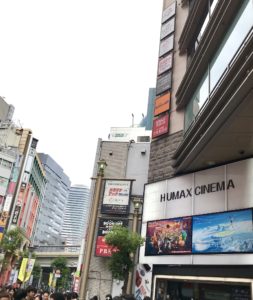
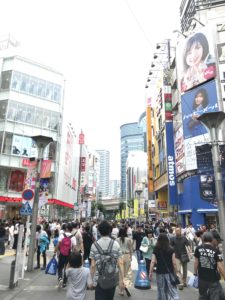

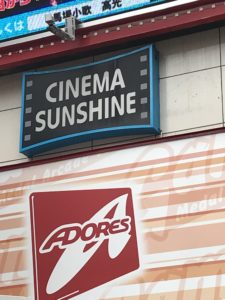
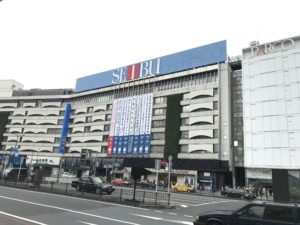
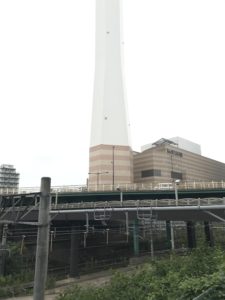
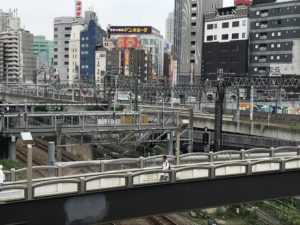
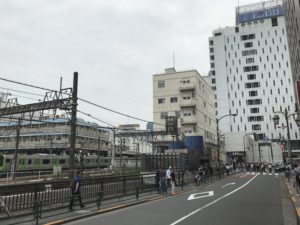
天気の子 (プロットネタバレをなるべく回避した) 所感
天気の子が期待を裏切らず大変に素晴らしい作品だったので、感動熱冷めやらぬ内に所感をメモ。
※やはり、先入観はなるべく排除して観るのが乙です!! プロットが読めてしまうような記述は、なるべく控える様にしています※
- 新海 御大、並びに制作陣の熱量・拘りが今回も随所に垣間見える(というか2時間ぶっ通しで迸る)作品:
- われらの人生の紆余曲折・もがき・踏ん張り を後押ししてくれる肯定的テーマ・メッセージが随所で感じられる。
- 一方で「人生こうあるべき」と押しつけがましくない。台詞からも夫々のキャラクタ―(及び我ら人間共通)の機微がつまびらかに描写されており、解釈も視聴者の状況や年代にとって色々感情移入出来るけれど、人生(色々あるけど)賛歌・肯定してくれるメッセージは万人不変に訴求してくれる(はず)。
- 伏線を思わせぶりに散りばめていてくれるものの、程良く忘れた(というよりプロットに集中させてくれるので伏線をあまり意識しない)頃に回収してくれ、終始先の展開への期待が絶えない。
- 現実描写のリアル感にとことん拘っているので、違和感無く現実(といっても一般ピーポーが体験する日常よりは起伏のあるプロット)からフィクションの世界へと交差する場面に誘(いざな)ってくれる。
- それでも現実では中々こっ恥ずかしくて言えないような、クスリと笑えるやり取りや台詞があるのもアニメの醍醐味!(「先輩」呼称のくだりなど)
- 聖地巡礼: 劇場から出たら、ゼロ距離&秒で聖地巡礼が可能な稀有な作品。
- 東京都心部近郊であれば池袋のHUMAX CINEMAで観るのがお勧め。
- 今回もその他東京各所も随所に出てきます。
- 印象的なのは奥に新幹線が走る坂が見える田端付近か?
- 音楽: RADWIMPSは盤石の安定感。ジブリでいうところの久石譲タッグとなっていくのでしょう。
- エンドロール: 漢字名やAlphabet名が多く見受けられた。パイの取り合いにならない(良品がインスパイアされどんどん生まれる)アニメ産業はどんどん輸出するべき、というのは業界を知らないいち消費者の絵空事なのだろうか。(丁度タイムリーに京アニの凶報もあり、単純な帰結は出来ないのだろうが)
- 公開当初の天候: 丁度作中の天候設定が2019年6~7月にかけての東京の天候(ずっと雨)をかなりミラーしていて、偶然かもしれないが、本作の天気に対する洞察・訴えを身近に感じられる。天候変動に関に関しても作品を通じて問題提起しているのでしょう。
- 商標: チキンラーメン・ポテチ・カップヌードル・ソフトバンクのお父さん・Bossのビックネームが全面的に標榜されているようのは分かる。ただ「マンボー、マンボー」もそのままの存在感を放つ中、何故かアパホテルとドン・キホーテ(他にもあるかもしれない)は若干改名されていたところに、何か大人の事情を感じた。
- 平泉成さん: 声だけでも存在感十分。細かくて伝わらないモノマネ選手権のイメージがどうしても頭をよぎる中、人情味系警部の味わい深さは逸品。
- 新海作品の10代以下の精神成熟について:
- おしなべて10代(ぽいヤング)が主役でなので、「こういう人生のフェーズ(紆余曲折)は10代で卒業しなさい」という解釈を受けとってしまうのは、筆者の穿った人生観(及び所業)に依拠しているのか。。
- 四葉にしろ、今回の凪にしろ、どうも最年少キャラが異様にしっかりしているのは、「フィクションだから」という帰結としたい。(最近の少年少女はこんなにスペック高いの?)
「君の名は」という傑作のDNAを感じつつ、更にエンターテーメントとして昇華してくれた新たなマスターピースです。後3回は劇場で観れる!
※これより下は、感の良い方はPlotが読めてしまうかもしれないので、1回観てからの反芻用にご参照下さい※
鑑賞直後聖地巡礼の足跡:








- 鑑賞後の爽快感・満足感は今回も健在。どうしても現実はこうもドラマチックではないので、毎度現実に引き戻されざるを得ない「鑑賞後ロス」も不可避。
- 前作キャラ: 2人は明らかなのですが、テッシー、さやか、四葉も出ている模様(見つけられませんでした)。夫婦別姓が主流でないのを考慮すると色々と思惑(前作から何年後経過したか?、2人の行く末など)を自由に広げられる余地あり。
- 「人柱」という単語は、一般的な単語なのだろうか?: ハガレンやらナルトやらで触れた人はいるだろうけど、今作品でググった人も多いのでは。
- 特に印象的なシーン(旬をとっくに過ぎた拗らせ男子用):
- 平泉成警部「…人生棒にふっちゃってるからね。(中略)羨ましいよ」から壁に刻まれた伸長の足跡を見て>須賀さんに視点が移る一連のシーン
>アラサー拗らせ男子には染みる - 帆高自戒シーン「一番歳上じゃん」
> 自堕落なおっさん進行中の胸に突き刺さる
- 平泉成警部「…人生棒にふっちゃってるからね。(中略)羨ましいよ」から壁に刻まれた伸長の足跡を見て>須賀さんに視点が移る一連のシーン
琴線に触れるシーンが多すぎて書き(&思い返し)きれません。何回でも観れます。
How Japan conscripts and churns out a generation of tamed bureaucrats
Stumbled upon a gem from a school rulebook for an elementary school (to which kids aged from 6-12 are enrolled) in Japan. It shall be noted the 48 bullet points are meant to be read, understood and abided by 6 years’ old kids…
<Caveat>
Based on my own elementary school experience, I am relieved to testify that most schools are not as stringent as what is excerpted below and most children (and teachers alike) couldn’t care less about ostensibly absurd rules designated by school.
===XXXXX Elementary School Rulebook 2018===
[On the Way to School]
1. Students should arrive at school between 8:15-8:20 am.
2. For safety reasons, students should walk to school with a designated group of students, not alone (If a student realizes that he/she has left something home, he/she should directly come to school without going back home).
3. Absence, late arrival, early leaving or absence from PE class should be notified via parent-teacher notebook.
4. In case of late arrival or early leaving, students should come to school/ go home with their parent.
5. Students should bring only necessary things to school (They can bring their own water flasks throughout the year, but should look after them themselves).
6. Students can bring money to school only when money is collected by school. The money should be put in a money envelope and handed to the class teacher.
7. Outdoor shoes should be taken off before going on the boards in the shoebox area. Shoes should be worn properly (without stepping on the back of the shoes).
8. In case of leaving indoor shoes home, they can be borrowed from the class teacher. The shoes borrowed should be washed and returned to the teacher.
9. Students should go into the classroom and make preparations as soon as they arrive at school.
[During Class]
10. A book to be read during the reading time should be prepared by the time it starts. The book should not be a manga or textbook.
11. Easy-to-use pencils and erasers should be prepared (Flavored ones or kneaded eraser are prohibited).
12. Five pencils, one red pencil, eraser, ruler and permanent marker should be put in a pencil case. (Colored pens can be used up to three colors depending on the grade).
13. Plastic sheet (called Shita-jiki) should be used when writing in a notebook.
14. Students should call their friends with “-San” (One of the honorifics used in Japan).
15. Designated tools should be prepared in a toolbox (Content varies depending on the grade and should be confirmed at the beginning of the new grade).
16. Students should use their own devices/ tools and should not borrow them from each other.
[PE Clas]
17. PE shirt should be tacked into the half pants.
18. Red/white reversible cap should be worn. Long hair should be tied with elastic hairband.
19. PE shirt should be worn without undershirt (in order to avoid wearing sweaty undershirt).
20. When it is cold, students can layer clothing (such as sweat shirt) until body is warmed up. Hoodie/ front-open (such as zipped) top should be avoided for safety reasons. Tights/ leggings should be taken off.
[Calligraphy/ Art/ Music Class]
21. Calligraphy tools (calligraphy brush) are to be taken home on the day when they are used and washed.
22. Pallet/brush for painting can be washed at the sink in the school.
23. Students should prepare a music bag and keep the textbook, recorder, songbook and music file in there. (Students in the third grade or above)
24. Approval should be gained from the teacher when entering into another classroom except their own one.
25. Students should walk on the right side of the corridor/ stairs in a quiet manner.
26. The whole class should walk in two lines on the right side in a quiet manner when moving to special class/ returning to the classroom.
27. Students should inform the class teacher before going to the school nurse office. One student who is asked by the teacher will accompany the sick student to the nurse office.
[Break]
28. Outside playing areas are the playground and pilotis (Students should not go behind the school lunch kitchen).
29. The pilotis is only for unicycle and stilts ride (The playground can be used for skip rope or tig).
30. When playing with a ball, students should pay attention to their surroundings (Playing around the stairs or ball kicking are not permitted).
31. Equipment used should be tidily put away in the designated place (Balls and skip ropes should be kept in the classroom. Unicycle and stilts should be kept in front of the columned school building hatchway).
32. Students should stop playing, prepare for the class and wait in a quiet manner when the bell goes off (to be seated at the time of the bell).
[Lunch]
33. Students on lunch serving duty should wear a mask, line up and get dressed (Hair should be tucked into the hat).
34. Students on lunch serving duty should walk in line in a quiet manner (walk on the left side only during the lunch time).
35. Students in charge of wiping (Paper Person) should walk after the line and immediately wipe whatever is spilt.
36. Students should be seated and wait in a quiet manner with mask and hat on when they are not in charge of serving.
37. Equipment for lunch such as dish carrying basket, food carrying container or rise container should be placed on the serving table or desk and should not be placed on the floor.
38. Lids for the containers should not be placed underneath the food carrying container when serving.
39. Leftovers should be returned to the food carrying container and the dishes should be sorted and returned (Leftovers, rice grains or soup should not be left on the dishes).
40. Rice scoop, ladle and milk carton should be returned to the designated places (They should not be left in the food carrying containers).
41. White gowns should be taken home at the end of the week and washed and returned to school at the beginning of the week.
42. Students should be seated and wait until all the students can say “Gochiso-sama” (Word said after the meal to express gratitude for the meal).
[Cleaning]
43. Wiping cloth should be washed in a bucket, not directly in the sink.
44. At the end of the cleaning, students should make sure that all the equipment is returned to the designated places before exchanging greetings.
45. Rubbish should be separated and taken to the rubbish pit in front of the new school building hatchway.
[Short Meeting before Going Home]
46. Students should leave their belongings on the desk, keep good posture and say good-bye.
47. Indoor shoes and PE kits should be taken home over the weekend, washed and brought back at the beginning of the week.
[Clubs/ Student Committee]
48. Personal belongings should be taken to the club/ committee activity places, from where students are to go home after the activities.
===UNQUOTE (End of Post)===
Pantheistic New Year’s Day 2018
Traditionally, it is a custom for Japanese families to get together around year-end/new-year at their home town (usually children who moved out of their home town are supposed to come back) and pay a visit to some local shrine or temple for the new year prayer. What is particular in Japan is: this new-year prayer is more cultural than religious/spritual.
Granted many of us stumble upon Shintoist/Buddhist (as the 2 most predominant religions in Japan) events along the course of our life (e.g. marriage, child-birth, funeral etc), but the majority of Japanese don’t feel affiliated with any religion, and not necessarily conscious of religious gestures/implications of such events.
The same is true for me, and the followings are some snapshots of my new-year day and they would give some idea on how non-selective we could be when it comes to scratching the surface of religions (without commiting rigorously)
Yasukuni Shrine (靖国神社)
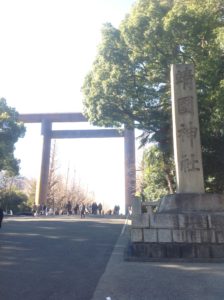
晩白柚 (Citrus grandis)
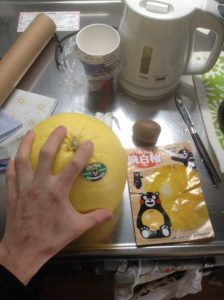
St. Mary’s Cathedral


Gokokuji Temple (護国寺)
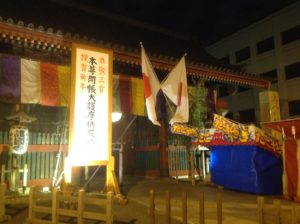
Catch up over greasy ramen / in Japanese garden
Had 2 batches of friends from overseas over the course of last Christmas weekend.
Random memo:
- Queued 70 mins (13:30- 14:40) for having a Ramen @ Mutekiya (無敵家) in Ikebukuro (池袋)
- Since any food is good enough in Japan and I don’t distinguish the spectrum of deliciousness beyond my generously-low threshold of tastiness, I don’t see the point of queueing for foods (or everything else) in Japan (or anywhere else). I just hate to queue and people who blindly follow whatever popular/trendy etc.
- Nevertheless, having friends to catch up with, alleviates the pain of queueing.
- Mutekiya Ramen (the one recommended best) is tasty during the initial several scoops, but it gets too greasy to eat (unless you like a greasy and thick-tasted ramen, as I do). It would be wise to choose a ramen with a different soup other than the most orthodox one (as in the case of Mutekiya Ramen).
- Visited Koishikawa Korakuen (小石川後楽園) with another friend.
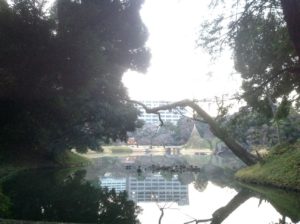
- Not much of serenity (due to the adjacently located amusement park and baseball stadium), but the varied configuration of Edo-era artifacts/structures and vegetation/ponds in the center of Tokyo are worthy of paying 300 yen entrance fee (as of Dec. 2017).
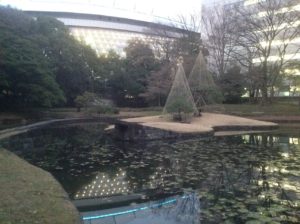
- The space of 6 years+ makes it difficult to recognize a friend who does not have a Facebook account.
Governance Fallout of Japan Inc. and “Compliance Vigilantism”
Gist of this post:
- Recent quality-related scandals by Japanese companies could be an indication of the shift of how Japanese companies started to assign the glut of employees (who are immune to lay-off due to the life-time employment practice) to the auditing/compliance functions (or whatever institutes designed to eliminate the non-conformance of the set standards) . The increased deployment of manpower (and the morale of such re-purposed employees) has led to the application of rigorous standards (which might be too stringent) and that might have contributed to the increase in deviations from the heightened standards.
- In short, the increased disclosure of scandals does not necessarily reflect the decline of corporate governance in Japanese companies. However, the already-attracted social attention would probably call for some mechanisms to enhance the “corporate governance”, and it is likely to accelerate the zeitgeist of endorsing “compliance vigilantism” (facilitated by the diligence and fastidiousness endowed in the Japanese) .
- In my skewed opinion, the recent focus on compliance has become too excessive to the point of hindering the wholesome culture of product/service creation.
Lately there has been an abundance of news related to the major Japanese corporations who have been revealed to have conducted some form of falsification or omission of quality-control/assurance processes.
The general reaction to this recent chain of scandals is somewhere along the line of: “The rock-solid quality standards/products of Japanese manufacturers has become a thing of the past, and can no longer be trusted”, or similar forebodings lamenting the general decline of trust toward the good-old Japanese corporations.
While these views have a point and the deterioration of quality standards of Japanese companies is indeed a concern that unnerves the long-lasting trust in Japanese manufacturers; however, my concern lies at a different aspect: Disproportionate focus/resources deployed to ensure compliance, (as opposed to product/service delivery).
As the delivery of products/services always precedes the quality control of delivery processes, the emphasis on auditing (or process control) is a likely indication of how mature and sophisticated the industry has become.
Meanwhile, the notable downside of “auditing” process (or whatever institute designed to enhance companies’ capacity to conform to designated standards) is that it more or less requires the allocation of resources that could have been otherwise dedicated for creation of products/services. Inherently, it is costly to place quality control measures (unless such measures effectively remove the flaws/inefficiencies of delivery process). This is why we don’t expect much of quality when it comes to low-cost products/services, and it would be fair to conclude that there is a general decline in how Japanese companies place priorities in quality assurance (to reduce the costs associated).
However, it is worth revisiting the fact that pointing out flaws (or points of improvement) in the delivery process is relatively easy, compared to making products/services, and moreover such auditing could be never-ending, especially considering the complexities of modern delivery networks and the litany of points that could be potentially improved.
My intention is neither; deny the importance of quality control nor enumerate empirical evidence to advance my view, but I sense that the zeitgeist of “compliance” has become too domineering to the point of creating some Japan-specific phenomenon: Emergence of senior Japanese salarymen (who had been once dispirited and astray along their life-time career), with the newly-found mission of “rectifying” the non-conformance of production/delivery processes.
Based on my skewed, yet first-hand insight/experience of working in one of such Japanese companies, the expansion of auditing/compliance departments (or whatever authority which triumphantly identifies and preempts potential deviations from the specified rules and standards) has become more conspicuous in recent years. The increase of senior salarymen assigned in such departments is correspondingly evident, and more is the case for the morale of these “compliance crusaders” whose rejuvenated enthusiasm seems to be occasionally in conflict with the primary business objective of delivering product/service. With all due respect to the auditing/compliance functions, but too much of it becomes “nitpicking”, which is easy for anybody to do, but unworthy of consuming time and manpower.
Given the difficulty of retrenching workforce in Japan (low labor mobility) and the plenitude of employees who passively benefit from such lack of risk of job loss (with less exposure to meritocracy), it has always been a task for Japanese corporations to come up with ways to motivate and deploy these “fixed” workforce (on top of rightsizing workforce by adjusting handily-disposable contract staff).
As exemplified by “Madogiwa-zoku” (“Window ledge tribe”): a term referring to a cluster of employees (usually senior) with little chance of career advancement, thus assigned to some obscure department in a company, the excess of career-stagnant employees has been somewhat a hallmark of big Japanese companies. With the increasing societal/industrial demand in compliance/auditing however, assigning such previously adrift workforce to these types of functions (be it internal department or external agency) appears to serve as a quick fix for mitigating the surplus of employees because of rigidly defined tasks (what needs to be done is clearly set), diligence & meticulousness of Japanese employees (under the clearly defined rules and guidelines), relatively attainable sense of achievement/improvement, authority over other departments/parties, etc.
Nevertheless, ensuring the compliance is essentially not intended to “create” products/services. Amid 2-decades-long economic stagnation, what Japan needs more is “creation” of new products/services/industries, rather than “improvement” of (already highly mature) existing delivery/manufacture processes. Even though, the revelation of recent scandals seems to suggest the need to further strengthen the auditing mechanism, but I would argue the strengthening of auditing mechanism has already taken place in Japan, and it inevitably leads to the increase of more cases of deviation from the heightened standards (which is the reason for the recent increase in the “supposed” scandals in Japan). Again, it is not my intention to downplay the severity of the issue, but misconducts are not only prevalent in Japan but also in other developed countries too. Besides, some scandals were utterly self-imposed (identified as “unfit” as per the internal standard). Perfecting the quality control is laudable, but it can never be achievable. Moreover the incremental improvement in quality (which could be negligible after a certain point) shall be evaluated in the context of resources that need to be deployed (people, time, cost etc.).
Instead of rambling on further, my conclusion is summarized in the first 3 bullet points in this post.
End of Post
Back in Tokyo (2014)
Having stayed 17 months abroad, I have to admit the entirety of living in where I was raised has been too nostalgic and endearing.
Though I was initially intending to be a social hermit and stay incognito in Tokyo, but let me know if you: 1. happen to come over/stay in Tokyo and 2. have too much time yet nothing productive to do other than meeting me up. The chances are grim due to the latter condition. Besides, I am as antisocial as I used to be, but I challenge you to contact me whenever you fancy. I will probably be around until May, 2015.
東京に帰ってきました。幸い職には溢れておりません。生活の具にノスタルジーを感じて涙がちょちょぎれそうです。暫く東京にいるので、親族孝行とクライミング再開(3-4年ぶり) が主なミッションです。但し、油を売ってくれれば、買う気概はありますのでご連絡下さい。
